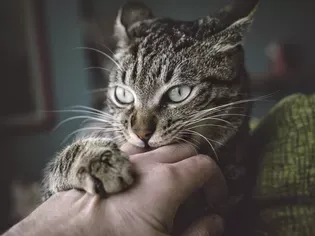How to Solve Behavior Problems in Cats
Updated on 04/26/24

Headline: Unveiling the Secrets to Solving Behavior Problems in Cats
Introduction:
Cats are enigmatic creatures that bring immense joy to our lives. However, their captivating nature can sometimes be overshadowed by perplexing behavior issues. If you're struggling to decipher the underlying causes behind your feline companion's odd quirks, this comprehensive guide will empower you with the knowledge and strategies to restore harmony to your household.
Understanding the Root of the Problem
Identifying the root cause of your cat's behavior is the first step towards finding an effective solution. Consider the following:
* Medical Issues: Rule out any underlying medical conditions that may be contributing to the problem. Consult with your veterinarian to screen for potential health issues.
* Environmental Stressors: Cats are sensitive to changes in their environment. Analyze your home for any factors that may be causing stress, such as new pets, visitors, or changes in routine.
* Developmental Stage: Cats go through different stages of development as they grow. Understanding their age-related behaviors can help you address issues specific to their life stage.
* History and Experiences: Explore your cat's past experiences and history to identify any potential triggers or traumas that may be influencing their behavior.
Common Behavior Problems and Solutions
Understanding the reasons behind your cat's behavior is crucial, but finding practical solutions is essential. Here are some common problems and their potential remedies:
* Aggression towards People or Other Animals:
* Identify triggers: Observe your cat's behavior and identify specific situations or stimuli that provoke aggression.
* Provide safe spaces: Establish designated areas where your cat feels secure and protected from perceived threats.
* Consider pheromone products: Pheromone diffusers or sprays can create a calming environment that reduces stress and aggression.
* Inappropriate Elimination:
* Rule out medical issues: Consult with a veterinarian to eliminate any underlying medical conditions that may be causing urinary tract problems.
* Clean up accidents thoroughly: Use enzymatic cleaners to remove all traces of urine or feces, as lingering odors can encourage repeated elimination.
* Provide adequate litter boxes: Ensure you have enough litter boxes for the number of cats in your household, and place them in quiet, easily accessible locations.
* Destructive Behavior:
* Address boredom: Provide your cat with interactive toys, puzzle feeders, and climbing structures to stimulate their mental and physical activity.
* Protect your belongings: Identify items your cat is particularly drawn to and make them inaccessible or unattractive by using deterrents such as citrus scents or double-sided tape.
* Consider a scratching post: Establish a designated scratching area to encourage your cat to channel their scratching instincts appropriately.
* Excessive Meowing or Vocalization:
* Rule out medical issues: Ensure your cat's excessive vocalization is not due to an underlying medical condition.
* Provide attention when appropriate: Reward your cat for quiet behavior and avoid giving them attention when they meow excessively.
* Enrich their environment: Ensure your cat has plenty of toys, hiding places, and activities to keep them entertained and reduce boredom.
* Compulsive Behavior (e.g., Over-grooming, Tail Chasing):
* Reduce stress: Identify and minimize potential sources of stress in your cat's environment.
* Provide enrichment: Offer your cat a variety of interactive toys, puzzle feeders, and opportunities for exploration to stimulate their minds and prevent boredom.
* Consider pheromone therapy: Pheromone diffusers or sprays can create a calming environment that may help reduce compulsive behaviors.
Remember:
Solving behavior problems in cats requires patience, consistency, and a holistic approach. By understanding the underlying causes, implementing appropriate solutions, and consulting with your veterinarian when necessary, you can create a harmonious and fulfilling relationship with your feline companion.
Explore More Pets

Cat Behavior Problems
How to Stop Aggression in Kittens

Long-Haired Cat Breeds
Siberian Cat: Breed Profile, Characteristics, & Care

Cat Behavior Problems
How to Stop Kittens From Scratching and Biting

Long-Haired Cat Breeds
Turkish Angora: Cat Breed Profile, Characteristics & Care

Basic Training
How to Socialize Your Kitten

Short-Haired Cat Breeds
Cute Pictures & Facts About Calico Cats & Kittens

Litter Box Training
Training Your Kitten to Use the Litter Box

Long-Haired Cat Breeds
10 Fun Facts About White Cats